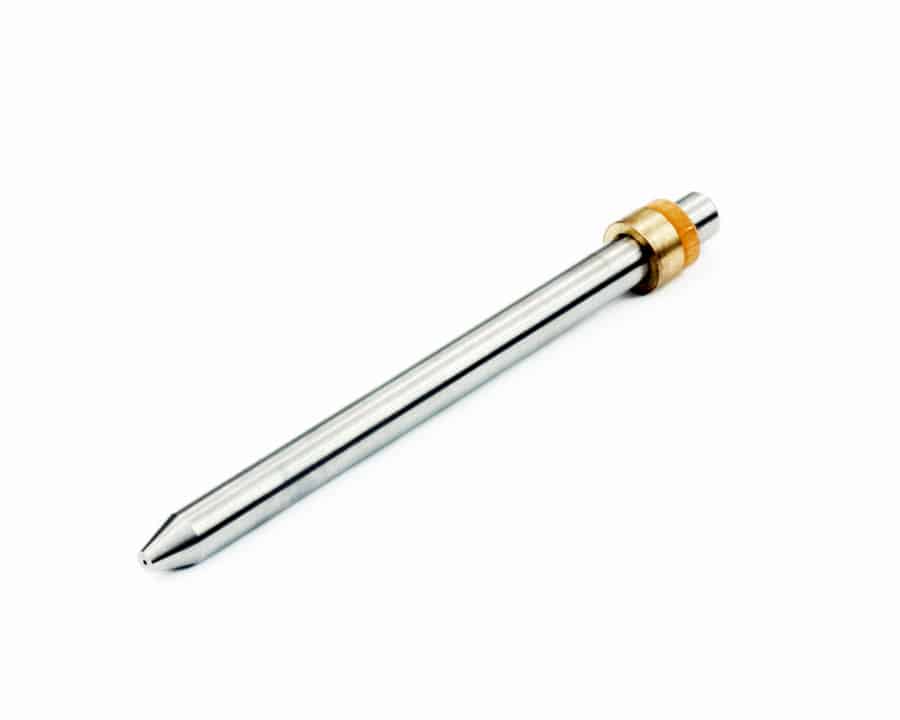In AWJ cutting, the nozzle plays a key role by converting high pressure to the high velocity necessary for cutting. The efficiency of this conversion process and the quality of the cut itself depends on the nozzle design, especially on the configuration of the mixing chamber. A number of studies are dedicated to the improvement of water and particles mixing.
1. A spiral nozzle was developed by Horri, 1990 (Fig. A.7) for use in efficient mixing of abrasive and improved focusing of spiral water jet streams in high pressure AWJ cutting applications. The development of this nozzle is based on the spiral flow theory. To obtain a focused jet flow, a nozzle is designed with an annular slit connected to a conical cylinder. Pressurized fluid is supplied through the slit (1) and the fluid, passing through the conical cylinder, is deformed into a spiral flow with the maximum axial flow on the axis. Abrasive is fed from the inlet (2) in the nozzle. Turbulent pipe flow is deformed into a spiral flow as the flow passes through the conical cylinder.
2. An apparatus (Fig. A.8) for improving abrasive mixing was developed by Kiyoshige, 1991. In this apparatus the ejecting water passes through a special path. The nozzle orifice has an upstream tapered portion. The diameter of this orifice gradually increases toward an upstream opening at which the orifice is connected smoothly to the downstream end of the ejected water passageway. The abrasive suspension is supplied to and merges with the streamlined flow of ejecting water near the junction of the water passageway. The resulting dual-layer streamlined jet has better cutting performance.
3.A new AWJ assembly (Fig. A.9) was suggested by Yie (1984). When multiple fluid orifices are utilized, an area of lower pressure is formed in the central portion of the combined fluid stream thereby aiding in the mixing of the solids into the fluid stream. A flow shaping nozzle is provided at the exit of apparatus to increase the mixing of the solid within the fluid jet stream. The flow shaping nozzle has axial and radial freedom of movement for forming the fluid-solid stream and self-alignment. The apparatus and process of this study, in one preferred embodiment, involves introduction of the solids in the form of a foam into the fluid jet stream. The particulate-fluid mixing devices provide pressurized fluid flow through the central portion of a nozzle and particulate are introduced peripherally. Thus, the fluid flow is not disturbed and the peripheral portion of the nozzle may be readily adapted to accommodate a wide variety of particulate requirements.
4.As it is known, slight angular misalignment of the nozzle makes the jet impact the focusing tube first, before exit. This causes quick erosion and distortion of the focusing tube as well as poor cut quality, due to non-uniform mixing of the abrasive with water. Alignment is usually carried out on-line manual by adjustment of the focusing tube and sapphire nozzle and it may require several iterative adjustments before satisfactory alignment is obtained. This problem can be arduous, time-consuming and frustrating. An alignable nozzle assembly was studied by Singh and Munoz, 1990. The alignable nozzle assembly described in this paper is comprised of the nozzle body, wear insert, focus tube, alignment screws, abrasive inlet fitting and nozzle. All parts are kept to a minimum manufacturing tolerances so that tolerance-based misalignment becomes acceptable. During operation, the alignment is carried out by tightening or loosening special screws around the nozzle holder.

